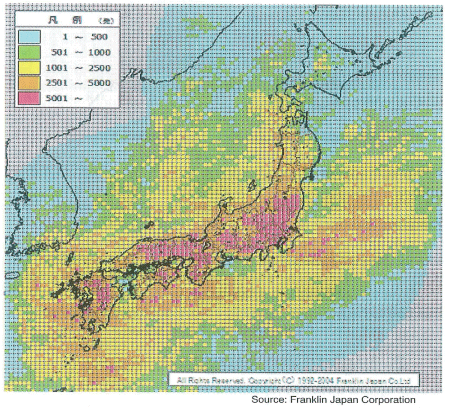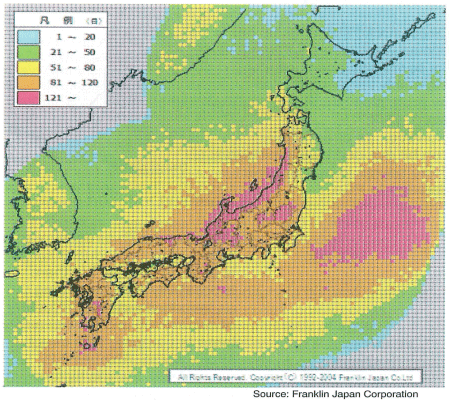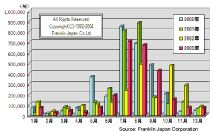| As shown in Table 3.1, lightning strike is listed up to cause
power failure in many cases.
Here, we would like to show the statistic data of lightning strike
that demonstrates how many strikes have occurred in Japan.
<< Nation wide lightning strike density map >>
(2000 to 2003: Integrated value for 4 years/20km)

Figure 3.1 Light strike density (frequency)
map
The figure above shows the integrated value of lightning strike
on the map that Japanese archipelago is partitioned into meshes
whose each side is 20km. Each mesh includes the integrated lightning
strikes for 4 years from 2000 to 2003.
Characteristic fact is that many lightning have struck major citiesin
Tokyo, Osaka, and vicinities of them whose population density is
very high as well an Kanto region (mainly Gunma and Tochigi prefectures)
famous for many lightning strikes.
<< Days of lightning strike map >>
(2000 to 2003: Integrated days for 4 years/20km)

Figure 3.2 Days of lightning strike map
The figure above shows the integrated value of lightning strike
on the map that Japanese archipelago is partitioned into meshes
whose each side is 20km. Each mesh includes the integrated days
of lightning strikes for 4 years from 2000 to 2003. Integrated days
of lightnint strike are very high on the Japan sea side from Tohoku
region to Hokuriku region. This is because the number of lightning
strike in winter season is added to number in the summer season.
In this region, many disasters caused by lightning strike occur
in the winter season as well.
<< Nationwide lightning strike by month >>
(2000 to 2003: 2000-square-km including Japanese archipelago)

Figure 3.3 Nationwide lightning strikes by
month
The graph above shows lightning strikes by month in the area of
2000-square-km including Japanese archipelago.
When it comes to lighting, it is the summer. The statistics indicates
the peak of lightning strike also is in May or October in addition
to midsummer. The peak greatly varies from year to year for many
reasons, for example, the peak in May, 2000 was due to "cold
air staying above and continuous good condition for lightning strike,"
the peak in October, 2002 was due to "nationwide lightning
strikes accompanied by cold front of atmospheric depression,"
and so on.
|

















